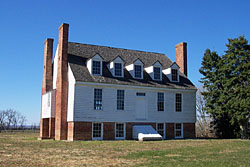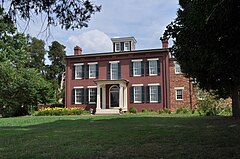Chippokes Plantation was established in 1617 by Captain William Powell of the Jamestown Settlement in the Virginia Colony. In 1967, the 1,700-acre (6.9 km2) plantation was donated to the Commonwealth of Virginia by Mrs. Victor Stewart for use as Chippokes State Park. One of the oldest working farms in the nation, Chippokes has kept its boundaries since the 17th century. The structures and artifacts on the property reflect plantation life from the early 17th century to the present. The antebellum Chippokes Mansion and the Chippokes Farm & Forestry Museum both offer scenic tours of the estate, cultivated formal gardens and woodlands.

Chippokes Plantation, a 1,400-acre farm located opposite Jamestown Island, has been the site of an active agricultural operation for nearly four centuries. Unlike many large plantations along the James River, it was never a family seat during the 17th or 18th centuries, but changed hands frequently, serving as a secondary plantation managed by overseers or farmed by tenants. Named for Choupocke, an Indian chief friendly to early English settlers, early owners of Chippokes included Governor Sir William Berkeley, who acquired the property in 1671, and the Ludwell family, who owned the property from 1684 to 1824. Chippokes Plantation consists of 20 historically significant buildings and structures, including two plantation houses. The River House, the oldest dwelling on the plantation, is a vernacular frame building that was doubled in size in the 1840s. Architecturally, the River House illustrates the continuation of a Virginia Tidewater vernacular tradition, whose beginning can be seen in earlier frame homes, such as Kittiewan.
Albert C. Jones purchased the plantation in 1837, and became the first owner to live there. Jones used the River House as his principal residence until he built an Italianate brick home on the property around 1855. This house, like nearby Lee Hall, reflects the liberal application of academic stylistic elements onto the regional forms and floor plans of the largest homes. Chippokes Plantation also retains an extensive collection of original plantation outbuildings, slave quarters, farm buildings and several colonial period archeological sites. In 1917 Mr. and Mrs. Victor Stewart purchased Chippokes, and lived here until 1967, when Mrs. Stewart donated the plantation to the Commonwealth of Virginia for the establishment of a museum of Virginia's agricultural history.
Chippokes Plantation is a part of the Chippokes Plantation State Park, located at 695 Chippokes Park Rd, Surry, VA 23883. It was listed on the Virginia Landmarks Register on November 5, 1968 and the National Register of Historic Places on October 1, 1969. For more information, please visit: Chippokes Plantation State Park or call (757) 294.3728.

Chippokes Plantation derives its name from Choapoke, the contact-era weroance of the Quiyoughcohannock people. The Quiyoughcohannock were a part of the Powhatan Paramount Chiefdom, with ancestral lands bounded by Upper Chippokes Creek and Lower Chippokes Creek. There were at least four towns in the nearly 100 square-mile territory, which drew their success from agriculture, trade, and the local waterways. The Quiyoughcohannock lands were ceded to English colonists by 1619.
As an Ancient Planter, a settler who had lived at the Jamestown settlement for 10 years, Captain William Powell was granted the 750-acre Chippokes Plantation tract in 1619 by the Virginia Company. Powell died just four years later in 1623. Chippokes Plantation passed to his infant son, George, in the care of Powell's widow, Margaret Powell Blaney West. When George Powell died childless in his early twenties, the plantation was purchased, sold, and repurchased by Governor William Berkeley. When Berkeley died in 1677, Chippokes passed to his widow, Lady Frances Culpeper Berkeley, who then married Philip Ludwell I.
Ludwells would go on to be proprietors of Chippokes Plantation for nearly 150 years. Notable Ludwells who owned Chippokes Plantation include Philip Ludwell III, the first known Orthodox Christian in America, and his daughter, Lucy Ludwell Paradise. Although she spent most of her life in England, Lucy managed to become close friends with Thomas Jefferson and John and Abigail Adams. After returning home to Virginia in 1805, she inhabited the Ludwell-Paradise House in Williamsburg, which is still standing today.
Chippokes Plantation saw its first non-absentee owner in 1837. Until this point, enslaved workers and paid white overseers lived on the property, while owners lived at a distance. Albert Carroll Jones, a wealthy 22-year-old from Isle of Wight County, first lived at Chippokes in the circa 1830 River House, built as a summer residence by previous owner Charles Osborne. Jones doubled the footprint of the River House in 1847. After his first wife, Anne Baskerville Jones, died in 1850, Albert began constructing a grand Italianate manor, the Jones-Stewart Mansion. Jones lived at Chippokes during and after the Civil War with his daughter, Mary Ann Jones, and his mother, Mary Anne Carroll Jones. Just before the Civil War, when Jones' prosperity as a planter and brandy manufacturer was at its height, Chippokes was home to 47 enslaved individuals, at least one of whom stayed on after the war. Jones died in 1882, leaving the property to pass through the hands of multiple family members before arriving at auction in 1918.
Victor Stewart and Thornton Jeffress, co-proprietors of the Petersburg-based Colonial Pine Company, bought Chippokes at this auction. Their intention was to timber the property, but Victor and his wife, Evelyn, decided to take up residence at Chippokes instead. Starting in the 1920s, the Stewarts restored the historic mansion and formal gardens. With no children to will the property to, the Stewarts instead chose to leave Chippokes Plantation to the Commonwealth of Virginia, with the stipulation that it would become a recreational park. Chippokes Plantation State Park opened to the public in 1970.
Noted for its continued agricultural production, today Chippokes Plantation is one of the oldest continuously-farmed properties in North America, having just passed its 400th anniversary. As a State Park, Chippokes offers modern recreational facilities, a swimming pool, visitor center, trails, camping, and cabin rentals. Ranger-led programs include historic house tours, guided hikes, craft workshops, costumed interpretation, and more. The park is also noteworthy for a section of riverfront that exhibits a large amount of miocene and pliocene marine fossil deposits.